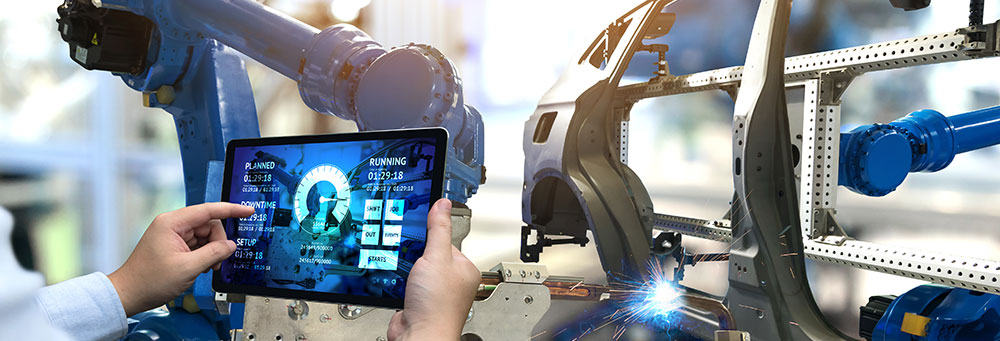The first industrial revolution introduced mechanization and steam power to industry. The second introduced electric power and mass-production, and the third introduced electronics, information technology, and automated production. Today, the fourth industrial revolution, or “Industry 4.0” is all about integration using digitalization and the Internet of Things (IoT).
Manufacturers can now integrate machines and systems online, improving productivity and customer satisfaction. Bernard Marr recently pointed out in Forbes: “As a result of the support of smart machines that keep getting smarter as they get access to more data, our factories will become more efficient and productive and less wasteful”- so adapting to industry 4.0 standards should be a priority for manufacturers.
The rapid advancement of technology has left many manufacturers with “legacy systems” and older machines which, despite being based on older technology, are critical to operations. These systems may be cumbersome and expensive to maintain, but the main issue is that they can’t provide a comprehensive, real-time picture of what’s happening in your factory, hindering real-time decision making.
Can Legacy Systems Be Transformed?
Many manufacturers believe their legacy systems are a barrier to industry 4.0. Despite the potential of Industry 4.0, a 2019 survey by Dell Technologies revealed that “a whopping 91 percent of midsize and larger organizations face major hurdles to digital transformation”, resulting in relatively few taking serious steps towards digitalization.
The truth is that legacy systems, unless modernized, can be a barrier to joining the Industry 4.0 revolution.
What Legacy Systems Need for industry 4.0
To adapt and compete, you could scrap all of your legacy systems and build a new infrastructure from scratch, but this is impractical. It’s expensive, and it means shutting down for weeks or months. You could take a complete inventory of your systems, scrap and replace some and try to update others, but that also takes time and money and could raise data privacy and security issues. Further, not every company has the in-house expertise necessary to implement such a strategy.
Fortunately, there are other options. Here’s what to avoid and what to implement in order to modernize your legacy systems:
-
Adopt IoT Sensors Which Can Run on Any Machine
IoT platforms use an array of sensors, which can be fixed to any machine, to collect data on a variety of critical factors. IoT sensors make sure your machines are running properly, with all operating parameters within a specified range. Data can be pushed and shared through all connected devices, improving effectiveness and functionality. IoT sensors allow automatic data collection from all machines on the shop floor and will alert you to problems before a breakdown occurs, for predictive maintenance and better control of production.
-
Avoid One-Size-Fits-All Solutions
You can try using an off-the-shelf ERP system to integrate machines departments and processes in your factory. But off-the-shelf solutions can be risky: they lack the flexibility necessary to facilitate long-term change and growth. They can’t produce feasible plans that take into account your company’s constantly changing operating conditions and strategic priorities. They can’t be updated in real time, and can never work as well as a best of breed integrated system.
-
Avoid Custom-Built In-House Solutions
Many manufacturers mistakenly assume that their IT team can easily write, test, and deploy a custom, in-house integration solution. In reality, this could take at least 6-12 months. In addition, your integration system will need constant in-house monitoring, upgrading, and maintenance, and it will need to adapt to changing business logic and integrate new systems. You will need a full-service, in-house support team that will grow along with the system. So, an in-house solution, while seemingly attractive, is expensive, time-consuming and inefficient in the long run.
-
Integrate All Data, From Production Floor, Legacy Systems and All Your Other Systems.
IoT sensors are only part of the solution. An integrated communications system can be installed to collect and integrate data from CRM, ERP, SCM, and PLM systems, as well as from the sensors on machines. Data can be displayed on easy to read, easy to understand consoles placed anywhere you want, including on a tablet or mobile device. This lets you collect, visualize, and analyze data from all areas of the factory from anywhere, so you can control and optimize production from start to finish.
Optimize for Industry 4.0, Even with Legacy Systems and Old Equipment
As Willem Sundblad recently pointed out: “The Industry 4.0 platform becomes a single source of truth for all manufacturing operations. Decision makers across the entire organization gain access to the same unified data set, rather than relying on disparate systems or manual data-collection.” Just because you’re “stuck” with legacy systems doesn’t mean you need to miss the fourth industrial revolution.
Magic’s FactoryEye gives you a competitive edge with smooth digitalized integration of legacy systems within 60 days, for better control, increased productivity, improved on-time delivery, and much more.
(function() { var qs,js,q,s,d=document, gi=d.getElementById, ce=d.createElement, gt=d.getElementsByTagName, id=”typef_orm_share”, b=”https://embed.typeform.com/”; if(!gi.call(d,id)){ js=ce.call(d,”script”); js.id=id; js.src=b+”embed.js”; q=gt.call(d,”script”)[0];




